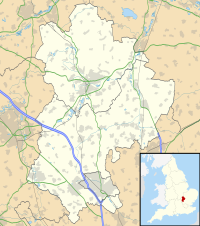| Toddington Castle | |
|---|---|
| Toddington, Bedfordshire, England | |
| Coordinates | 51°56′59″N 0°31′48″W / 51.9496°N 0.5299°W |
| Grid reference | grid reference TL0113128916 |
| Type | Motte-and-bailey |
| Height | 18ft |
| Site information | |
| Condition | Earthworks |
| Site history | |
| Built | 13th Century |
| Materials | Earth |
Toddington Castle, today known as "Conger Hill Motte", is an artificial earthen mound located in the village of Toddington, in the county of Bedfordshire, England.
Details
It was a motte-and-bailey castle, made first of timber and later of stone, that dates from prior to the 13th century when it was listed as the stronghold of Sir Paulinus Pegure (Paul Pever), who leased it from Roger Bigod, 2nd Earl of Norfolk.[1] The name Conger Hill is recorded from 1597 and it has been considered that the name may be a corruption of an earlier Celtic British name. The mound was used in the 16th century as a rabbit warren.[2]
The site is a Scheduled Monument, classified as a medieval motte. Only earthworks, which rise 18 ft above the present bottom of the moat and have a flat top 92 ft in diameter without trace of a rampart, remain.[2]
Folklore
For about 150 years, every Shrove Tuesday at Toddington, the 'pancake bell' was rung in the church to remind the women to make their pancakes. On hearing the bell, school children would then run to Conger Hill, put their ears to the ground and, supposedly, listen to the sizzling sound of the 'old woman' frying her pancakes.[3] The last outing of this kind ceased in the early 1970s, perhaps due to the Church's reluctance to be associated with witchcraft, but the tradition was revived in 2012.[1]
See also
References
- ^ a b "Origins of The Witch and the Pancakes". myths.e2bn.org. Retrieved 24 August 2021.
- ^ a b England, Historic. "Heritage Gateway". www.heritagegateway.org.uk. Retrieved 24 August 2021.
- ^ Toufexi, Ioanna (14 February 2021). "Pancake Day tradition sees kids gather on a Beds hill and listen for witches". bedfordshirelive. Retrieved 24 August 2021.

